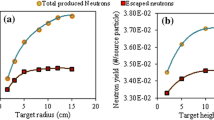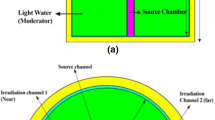Abstract
The epithermal beamline at the Portuguese Research Reactor is being optimized for Prompt Gamma Neutron Activation Analysis (PGNAA). One of the major changes is to thermalise the beam by the introduction of a sapphire crystal into the beamline. Placing the sapphire at the exit of the beamline would greatly reduce the alterations and work necessary to the port and make the crystal easily removable. However, the scattered neutrons from the sapphire would increase both the neutron-induced detector damage and the background radiation. MCNPX was used to simulate the crystal in the beam port and at the exit of the port.
Similar content being viewed by others
Avoid common mistakes on your manuscript.
Introduction
The Technological and Nuclear Institute is in the very initial stages of modifying facilities at the Portuguese Research Reactor (RPI) for Prompt Gamma Neutron Activation Analysis (PGNAA) for a variety of sample types. An epithermal beamline exists but requires extensive modifications to thermalise the beam and to reduce background radiation. The beamline was made available to other applications, therefore the modifications have to be limited and adaptable. MCNPX [1] was used to simulate various proposals.
Figure 1 shows the model of the current state (Fig. 1b) of the beamline and proposed modifications (Fig. 1a and c). The beam port contains a Be reflector by the core followed by an Al filter. The beam is collimated through lead, polyethylene and boral tubes to a diameter of 6.2 cm. A shutter at the port exit allows for further collimation of the beam to 2 or 5 cm in diameter and a cadmium shutter can be used to block the thermal component.
MCNPX Models of the epithermal beamline at the Portuguese Research Reactor. a Proposed modifications with sapphire crystal placed in beam port. b As the beamline is at present. c Proposed modifications with sapphire crystal placed at exit of beam port. d An example of a mesh tally. A view of a cross-section of the geometry is also shown
The sample chamber is built using a combination of concrete, baryte concrete, lead, Cd lining and polyethylene. The distance from the Be reflector to the sample position is approximately 370 cm. The detector port is at an angle of 270 degrees relative to the beam, as shown in Fig. 1b, thus protecting the detector from scattered neutrons. However with this configuration the detector cannot be placed very close to the sample. With a well-thermalised beam with a high flux and sufficient shielding, sensitive elemental analysis of samples will be achieved.
The suggested modifications include adding a sapphire crystal to the beam port. A new sample holder is to be built and the beam stop modified to reduce background radiation and protect the detector from fast neutrons. Polymer 10Li sheets, borated polyethylene blocks, lead and other shielding materials are to be incorporated to aid in shielding. Li polymer is used around the detector port and sample holder. The proposed changes should limit the background detected by the Ge detector. The detector dimensions match those of the detector being acquired.
There are three contributions from the simulations presented here: the modifications to the beam port are modelled to see the effect on the neutron spectrum, the thermalisation of the beam; the change in the number of neutrons reaching the shielding is presented; and the degree of success in shielding the detector from background radiation. Several MCNP models were used. Models of the existing facilities and modified port and chamber were built, and simulations performed to determine the change in the neutron flux.
Sapphire, Al2O3, is an efficient filter of fast neutrons and reduces the gamma background radiation from the core. It also has the benefit of being effective at room temperature with only small gains achieved by cooling. The transmission of neutrons through super optical quality single/crystal sapphire filters has been determined by Mildner et al. [2]. They found lattice distortions increased attenuation at thermal and subthermal energies. The filters were compiled using blocks of small crystals, approximately 25 mm. We plan to use one larger crystal of optical quality, 100 mm in length and diameter.
Stamatelatos and Messoloras [3] used MCNP-4B to determine the optimum thickness of a sapphire filter and found a large variation in the quality factor, which they defined by the ratio of fast to thermal neutron transmission. The size of the crystal has already been determined; of importance in the calculations is the position of the crystal and change in spectra at the sample position and the change in the fast neutron dose to the detector. However, we must assume that the crystal, especially of such a size, will not be optimal.
Experimental
The Monte Carlo code MCNX 2.5 [1] using ENDF (Evaluated Nuclear Data File) libraries was used to model the changes in the beam port and beam chamber. Several models were built to model the changes to the beam line. Particles (40 million) were simulated for each experiment, more than enough to ensure that all tallies passed all statistical tests. The source was assumed to be a circular source from the entrance of the port at the Be reflector. In later simulations, the source was moved forward ahead of the main filters as to measure the change in transmission and change in dose at various cells. Only neutrons were transported although the model will be used to determine gamma production and background in later simulations.
A spherical cell of a biological composition ICRP (The International Commission on Radiological Protection) soft tissue with a radius of 0.5 cm is built into the model to take into account scattering and also for later simulations with photon transport. Figure 1 shows an example of an F4 mesh tally. Energy-binned F4 tallies, 1 cm2 at the centre of the beam, were used to measure the change in flux at three positions along the beamline, before the sapphire filter, after the filter and at the sample position.
The thermal flux is in the region of 3.1 × 107 thermal neutrons cm−2 s −1, 1.1 × 106 epithermal neutrons cm−2 s −1 and 2.6 × 106 fast neutrons cm−2 s −1 at the sample position although these measurements were taken many years ago. The thermal flux was confirmed with gold foils recently. This ratio was used to build an energy-binned source, a spectrum from theory (Maxwell/Boltzmann, fission and epithermal spectra) assuming room temperature thermal spectrum. The distribution and flux of the beam at the sample position were measured using gold foils positioned in a cross formation in the path of the beam. In 2008, the reactor was undergoing a change in the core configuration hence the source will be altered. The model presented is therefore a reflection of the last current state, based upon assumptions.
Results and discussion
As shown in Fig. 4, the number of neutrons reaching the detector is 27% of that if the crystal is placed at the exit, and only 1.4% compared to the current situation. Moreover, photon background will be reduced to a much greater extent.
The transmission of filters is dependent on several cross/sections (Bragg/scattering, absorption, incoherent and coherent). The absorption cross section increases linearly in the thermal/cold region, reducing the flux of cold neutrons. As shown in Figs. 2 and 3, the results indicate a 35% loss of neutrons in the crystal. One omission from the model was the orientation of the lattice structure of the sapphire and also the quality of the crystal is also a factor that affects the transmission and scattering. The coherent Bragg scattering allows higher transmission of neutrons and is dependent on the orientation and quality of the crystal. Small changes have been observed for the transmission in the orientation of the crystal but they are small however these were measured using small, perfect crystals. About 40% of the particles in the simulation entered the adjacent, surrounding materials of the crystal. Hence such a large scattering significantly reduces the flux.
Whenever possible, scattering cross/section libraries were used for materials in the simulations. This is necessary for accurate simulation of thermal neutron transport; however there is no specific library for sapphire hence the loss of thermal neutrons to scattering may differ.
Figure 3 shows the transmission but this differs from the Cassel equation [4] for transmission of sapphire crystals, where the peak transmission is approximately 0.02 eV, dropping rapidly for higher energies and decreasing more slowly for decreasing energy. The proportion of thermal neutrons decreases as would be expected for very low energy neutrons where transmission drops. Moreover, at the sample position there is scattering and energy-dependent diversion of the beam. The brightness changes (defined by steradians) and is energy dependent. This can be seen by the contrast in the flux at the centre of the beam after the sapphire and at the sample position.
Figure 4 shows the relative neutron spectra for the HPGe detector and shows the distribution of neutron energies, a factor in activation and also indicative of the source of the neutron. Figure 4 shows a large decrease in the number of neutrons reaching the detector, with a threefold increase with the sapphire placed at the beam exit rather than in the port. The decrease in radiation may also allow the experiment to take place with the section of the top of the beam to be removed. Currently, placing a sample in the chamber involves using a crane to remove a section of the lid of the chamber and this takes a considerable amount of time. With a thermalised beam the top may be removed.
The MCNPX model has helped us to plan for the modifications to the beam. The position of the sapphire affects the neutron dose to the detector. The change in the dose to the concrete beam stop reduces the background radiation hitting the detector. The next step in the model would be to introduce accurate photon transport to measure the source of background. At the current setup, high background is expected and it is also another reason why placing the sapphire in the port would be required. By placing the crystal at the port exit would increase the gamma background from the scattered neutrons. We plan to determine this effect in later simulations. Sources of scattered neutrons can be measured using F5 radiographic tallies and the results will be presented in a later paper.
Conclusions
The sapphire filter will need to be placed into the sapphire port to reduce the neutron damage to the detector and to reduce significantly the gamma background, essential for accurate Prompt Gamma Activation Analysis. Further measurements are required to validate the model. Photon transportation will be incorporated into the models and further analysis of scattering using F5 tallies will help identify sources of background.
References
Pelowitz, D.B.: MCNPX-TM user’s manual, LA-CP-05-0369, Los Alamos National Laboratory (2005)
Mildner, D.F.R., Arif, M., Stone, C.A., Crafword, R.K.: J. Appl. Cryst. 26, 438 (1993)
Stamatelatos, I.E., Messoloras, S.: Rev. Sci. Instrum. 71, 70 (2000)
Cassels, J.M.: Prog. Nucl. Phys. 1, 185 (1950)
Author information
Authors and Affiliations
Corresponding author
Rights and permissions
About this article
Cite this article
Beasley, D.G., Alghamdi, A., Freitas, M.C. et al. Simulating the introduction of a sapphire crystal into an epithermal neutron beamline. J Radioanal Nucl Chem 281, 307–311 (2009). https://doi.org/10.1007/s10967-009-0096-5
Received:
Published:
Issue Date:
DOI: https://doi.org/10.1007/s10967-009-0096-5








